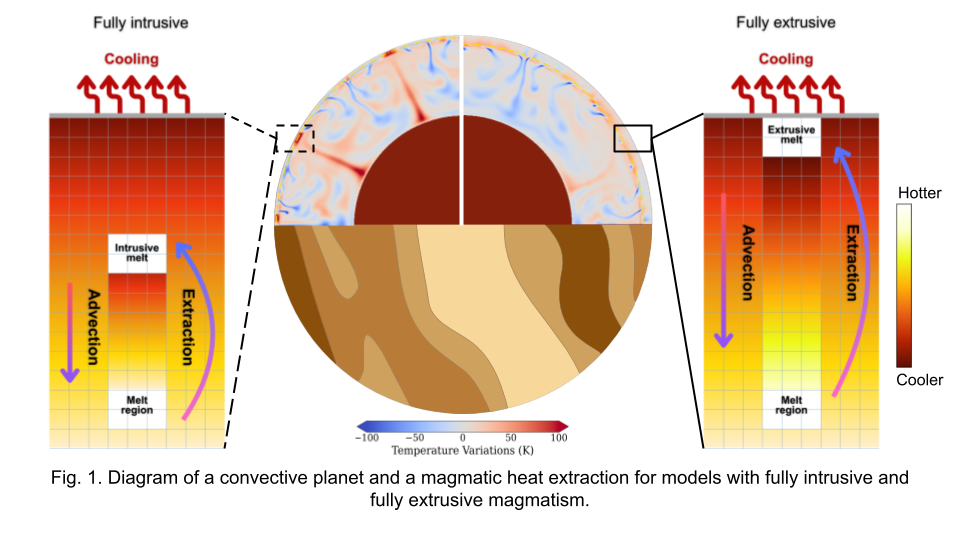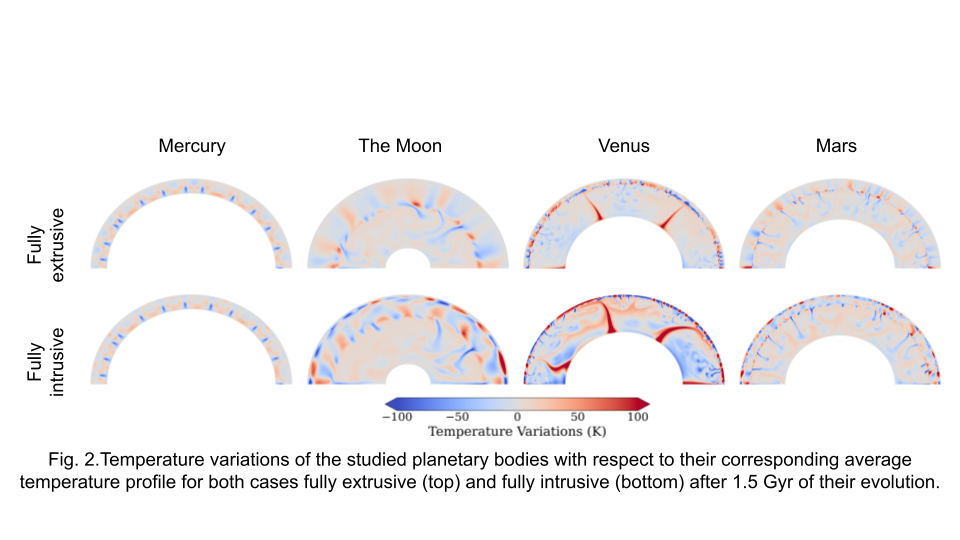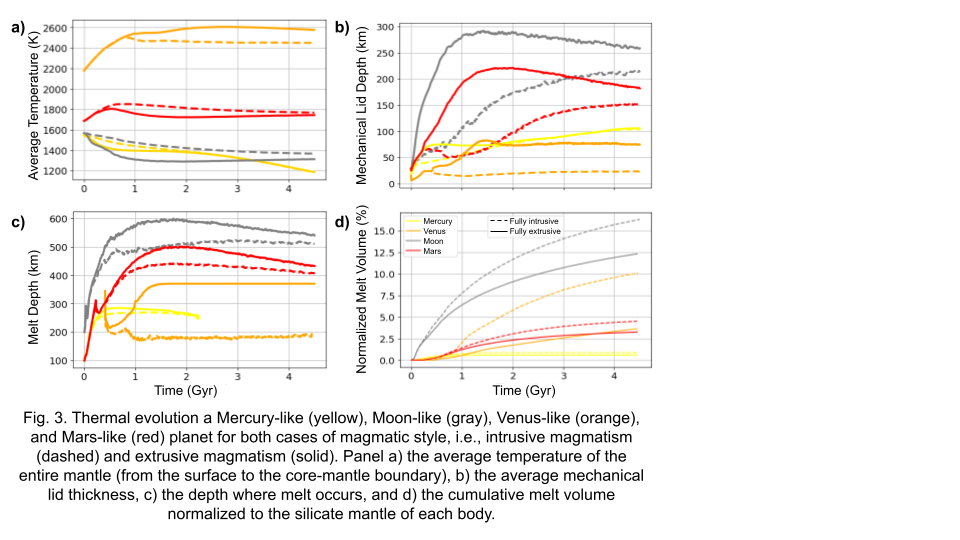Effects of magmatic styles on the thermal evolution of planetary interiors
- 1German Aerospace Center (DLR), Institute of Planetary Research, Germany (carianna.herrera@dlr.de)
- 2University of Münster (WWU), Institute of Mineralogy, Münster, Germany
ABSTRACT
Previous studies have suggested that extrusive magmatism efficiently cools planetary interiors but the contribution by intrusive magmatism has been little investigated so far. We study the effects of the magmatic style (i.e., intrusive vs. extrusive magmatism) on the thermal evolution of Mercury-, Venus-, Moon-, and Mars-like bodies. Our results suggest that different magmatic styles strongly affect the thermal evolution of planets, where for instance intrusive magmatism allows for thinner lids, cooler melts and more melt production. In addition, for large and/or highly magmatically active planets such as Venus, an intrusive magmatism allows for more efficient cooling of the interior.
INTRODUCTION
Volcanic activity has been evidenced on planetary bodies across the inner solar system [1]. Mercury's volcanic surface expressions are extrusive volcanic vents, pyroclastic deposits, lava flow margins, etc.; and studies have analyzed their history in terms of the effect of the planetary cooling who led to the global contraction [2,3]. Venus surface is dominated by volcanoes, flow fields, volcanic vents, and coronae, among other features [4]. Recent analysis of radar data collected by the Magellan mission suggests that there could be volcanic activity still ongoing on Venus [5].
Volcanism has also shaped the lunar surface, leading to the formation of a variety of volcanic landforms such as lunar maria, lava flows, domes, cones, etc., features that were confirmed after a series of lunar exploration missions and even directly studied thanks to the return of samples from the lunar surface [6,7]. The extensive volcanic products on Mars account a large variety of explosive [8] and sedimentary volcanism [9], and recent studies presented geophysical evidence for active volcanic processes in the Elysium Planitia region [10,11].
These volcanic features are witnesses of magmatic processes that these bodies have experienced, but the amount of intrusive vs. extrusive melt that was produced during the thermal history is difficult to constrain. Extrusive magmatism has been suggested to allow more efficiently cooling of planetary interiors, but the role of intrusive magmatism on the thermal evolution has been little investigated.
In this study, we analyze the effect of the magmatic style (i.e. ‘fully intrusive’ vs. ‘fully extrusive’ magmatism end-members) by modelling the thermal evolution of Mercury, Venus, Moon, and Mars-like bodies. Our aim is to understand the effect of different magmatic styles for different planetary interiors rather than the particular evolution of the inner solar system bodies.
METHODS
We use the mantle convection code GAIA in a 2D spherical annulus geometry [12, 13]. Our models employ a temperature- and pressure-dependent viscosity that follows an Arrhenius law for diffusion creep [14, 15]. The strong temperature-dependence of the viscosity leads to the formation of a stagnant lid (an immobile layer) at the top of the convecting mantle, due to the cold temperature conditions. The thermal conductivity and thermal expansivity in our models are pressure- and temperature-dependent and we use parametrizations derived from ab-initio calculations and laboratory experiments [16]. We assume a homogeneous distribution of the heat sources and account for the decay in time of radioactive elements (i.e. 238U, 235U, 232Th, and 40K) and consider that the core cools with time.
Melting occurs when the mantle temperature exceeds the melting temperature. To keep the models as best as possible comparable with each other, we use the same melting curve parametrization as derived for the Earth’s interior [17]. We compute partial melting and consider two scenarios, i.e., fully intrusive and fully extrusive magmatism (Fig. 1). For all bodies, the depth of magmatic intrusions is set at 50 km depth. For scenarios where partial melting occurs deeper than the density crossover at ~11GPa [18], the melt is not buoyant enough to rise towards the surface and it is thus not considered in our models.

RESULTS
For all studied bodies, the convection pattern is characterized by stronger mantle plumes and more vigorous mantle flow for the fully intrusive cases than for the fully extrusive cases (Fig. 2). Additionally, the intrusive melt depth seems to control the stagnant lid growth with thinner lids for cases with magmatic intrusions.

While the global average temperature of the entire silicate part is higher for Mercury, Mars, and the Moon in the intrusive scenario compared to extrusive models, for Venus the opposite is the case (Fig. 3a). We explain this by Venus’s smaller lid-to-mantle thickness ratio and high melt production rate compared to Mercury, Mars, and the Moon. Normalized to their silicate mantles, the intrusive magmatism models produce more melt than the extrusive cases (Fig. 3d).

The mechanical lid depth of the intrusive cases is always shallower through time (Fig. 3b), diverging from the extrusive cases up to hundreds of kilometers. This is explained by higher thermal gradients and thus warmer lithospheres in the intrusive cases.
Mercury cools very quickly compared to the other planets and stops producing melt after the first half of its evolution (Fig. 3c). After that moment, the differences between the two scenarios are nearly identical. For all bodies, the intrusive magmatism cases melt at shallower depths with cooler melts during their evolution.
SUMMARY
Throughout the evolution of all studied bodies, the fully intrusive cases present thinner mechanical lids, cooler melt temperatures, more melt production, and shallower melting depths than the extrusive cases. Our results suggest that large and/or highly magmatically active planets such as Venus efficiently cool their interior through intrusive magmatism, while keeping at the same time a warm and thin lithosphere.
REFERENCES
[1] Byrne et al., Nat.Astron, 2020; [2] Thomas & Rothery, Elements, 2019; [3] Wright et al., J. Volcanol., 2021; [4] Ghail et al., Space Science Reviews, 2024; [5] Herrick & Hensley, Science, 2023; [6] Head, Rev Geophys., 1976; [7] Zhao et al, Space: Science & Technology, 2023; [8] Brož et al., J. Volcano., 2021; [9] Brož et al., Earth Surf. Dynam., 2023; [10] Broquet & Andrews-Hanna, Nat.Astron., 2023; [11] Stähler et al. Nat.Astron., 2022, [12] Hüttig et al., PEPI, 2013; [13] Fleury et al., Geochem.Geophys., 2024; [14] Karato et al., JGR, 1986; [15] Karato & Wu, 1993; [16] Tosi et al., PEPI, 2013; [17] Stixrude et al., EPSL, 2009; [18] Ohtani et al., Chem. Geol., 1995.
How to cite: Herrera, C., Plesa, A.-C., Maia, J., and Breuer, D.: Effects of magmatic styles on the thermal evolution of planetary interiors, Europlanet Science Congress 2024, Berlin, Germany, 8–13 Sep 2024, EPSC2024-650, https://doi.org/10.5194/epsc2024-650, 2024.